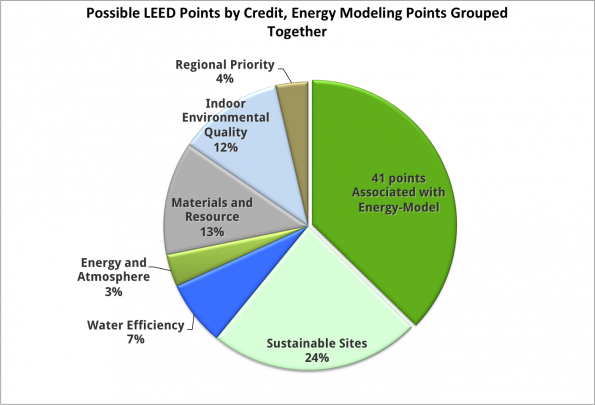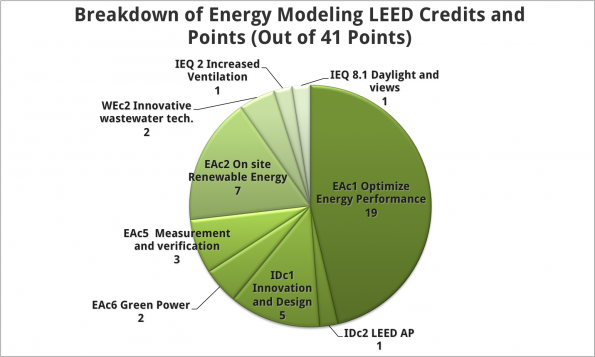LEED and Energy-Modeling
Are you a LEED AP? Do you know the ins and outs of energy-modeling?
If you can answer yes to both of these questions your portfolio will be on hyper-drive. Here, we are going to outline the TRUE importance of an Energy-model in LEED certification. In fact, we'll quantify it and also answer some beginner questions if you are new to the subject. We are also going to help you decide whether to do a model in house or hire a consultant (and also help you to avoid getting ripped off if you do hire a consultant).
What is LEED energy-modeling?
When someone refers to LEED energy-modeling, they are almost always referring to LEED Energy and Atmosphere credit 1, and likely Energy and Atmosphere pre-requisite 2. Also refer to our "What is energy-modeling page".
Why is it important for a LEED AP to know energy-modeling?
Well, the answer is simple math (and as a LEED AP, you are probably pretty good at math). There are 110 possible credits for a LEED building including all bonus points. Energy and atmosphere credit 1 is the single largest credit, with up to 19 points. Just how many of the total LEED points is this? Well, let's look at a pi chart of all the LEED points by credit:
This large piece of the pie, or these 19 LEED points are what most people consider to be the LEED energy model. HOWEVER, details used in the energy-model can also be used in other credits, which will increase your piece of the LEED pie. Some of the other points an energy model can earn you include(hover to display details):
- IDc1-2 Innovation and Design and LEED AP
- WEc2 Innovative wastewater technologies (2 points)
- EAc5 Measurement and Verification (3 points)
- EAc6 Green Power (2 points)
- EAc2 On site Renewable Energy (7 points)
- IEQc2 Increased Ventilation (1 point)
- IEQc8.1 Daylight and Views (1 point)
So, if we adjust the chart and subtract these aforementioned points from their current category and move them into the energy-model's portion of the pie, we get the true extent of the LEED energy-model. So, what does our adjusted chart look like now?
There are as many as 41 LEED points that are directly associated with LEED energy-modeling. Here is the beakdown of energy model LEED credits out of 41 total credits:
Just how many LEED points is this? Well, let's compare the number of LEED points that an energy-model can directly impact to the various LEED levels:
There are enough energy-modeling points to get a building LEED certified! Of course, with all the pre-requisites and complexities, we aren't recommending that anyone try this. We just wish to illustrate the importance of energy-modeling to LEED and to LEED AP's.
Why will it benefit a LEED AP to learn energy-modeling?
There are thousands of LEED AP's, but only a small percentage know how to create an energy-model in a legitimate software package such as TRACE 700 or eQUEST. An even smaller percentage are highly proficient. Why is this? Well, up until now, it has been easy to get LEED training, and difficult to get building simulation training.
What about the prescribed path for LEED Energy and Atmosphere credit 1?
Of course, you can go for the prescriptive path, but you can only get 1 point for the standard compliance path, or up to 3 points for the prescriptive advanced core performance option. If you are going for LEED silver, LEED Gold, or LEED Platinum, you NEED to complete an energy-model for LEED EAc1 (Which simultaneously meets the requirement of EAp2). You may hear that it is very expensive to complete an energy-model and therefore, you avoid these energy-modeling expenses at all costs. HOWEVER, the cost per credit can be quite low as opposed to other credits (that let's face it - other credits are bought just to meet the minimum requirements). For instance, if the company spends $5000 for bike racks and they get 1 point, it costs $5000/point. Given that energy-modeling can easily equate to 30 points or more (or a max of 41), well, you can do the math backwards
What is the cost of energy-modeling for LEED?
Now, the issue of cost for energy-modeling is highly disputed. The reason it is so expensive is that very few people can create valid models within a reasonable time frame. However, a rate of 20 cents per square foot is pretty common for high end modeling (as the buildings get larger than 120,000 square feet, this number might be 10-15 cents per square foot, but if you disagree, please comment!) The LEED energy-model is often, sub-sub-sub-consulted (and maybe more), and therefore, the price is highly inflated. I would suggest working directly with an energy-modeling firm as to complete any energy-model. Given that the model may be 60% of the total LEED consulting fees, this should be a no-brainer. Instead of having 1 consultant, you may wan to consider having 2 LEED consultants: 1 for General LEED and paperwork, and 1 for the energy-model (unless you are certain that the LEED consultant is giving you a good price on the model). A good energy-modeler can save you money on your design as well. It's easy for a good energy-modeler to cut out the "fluff" saving big dollars on design. Thus, a good modeler can save the money on the design.
Example: The team at energy-models.com recognized that a geothermal well might not be needed given consistent cooling and heating loads annually. We did some tests and found that the geothermal well, while 30% of the cost of the hydronic system, only added .5% additional savings. We reported our findings to a very happy, and suddenly under-budget design team.
Do you want to Learn LEED for energy modeling? Click here
IF you are really into modeling, you also might want to learn how to use LEED approved software! Click here
Bob Fassbender graduated from the University of Wisconsin - Madison with a degree in Chemical-Engineering. Following graduation, he spent 3 years working as a Marketing Engineer for Trane C.D.S. In the C.D.S. group, Bob developed and supported design and analysis software, primarily TRACE 700™. In addition to his development work, Bob also traveled around the country as a TRACE 700™ and System Analyzer™ instructor. Bob is also an experienced user with eQUEST energy modeling software. Today, Bob continues training and energy modeling as a LEED accredited professional (with a focus on LEED EA credit 1).




